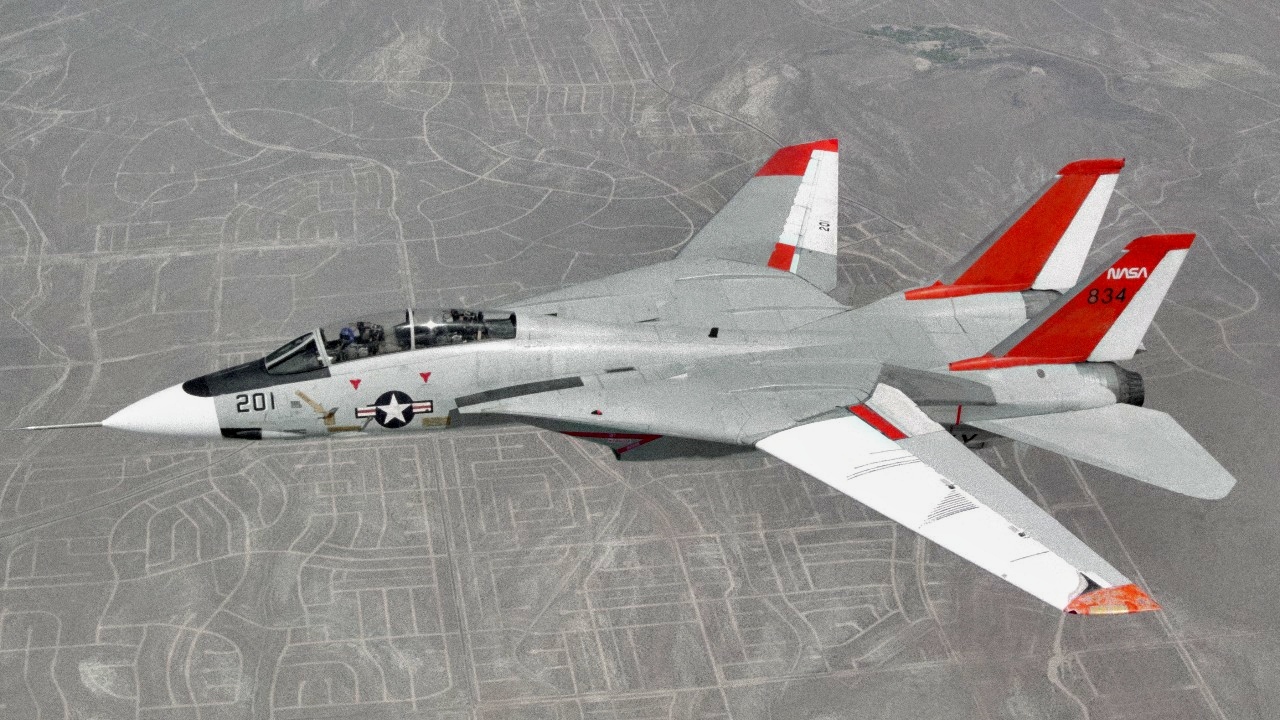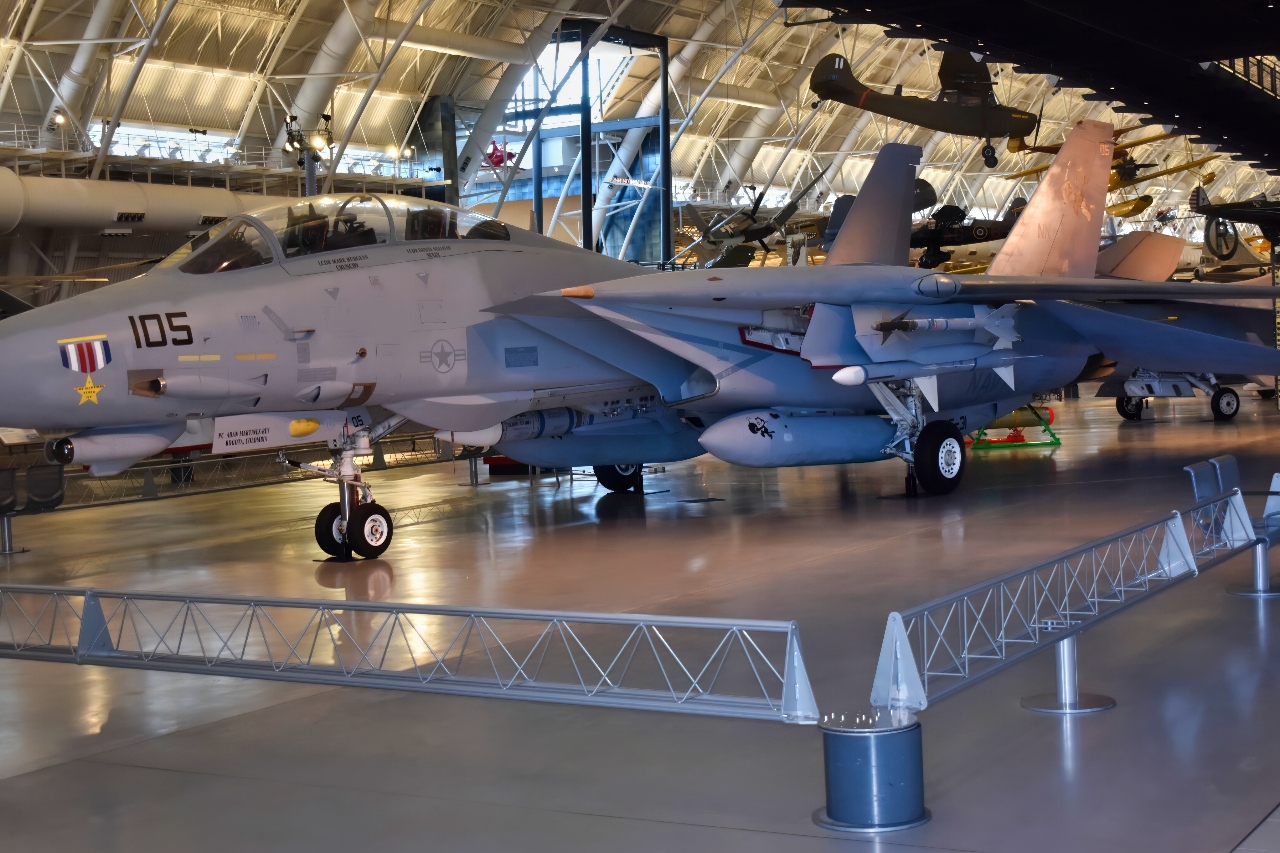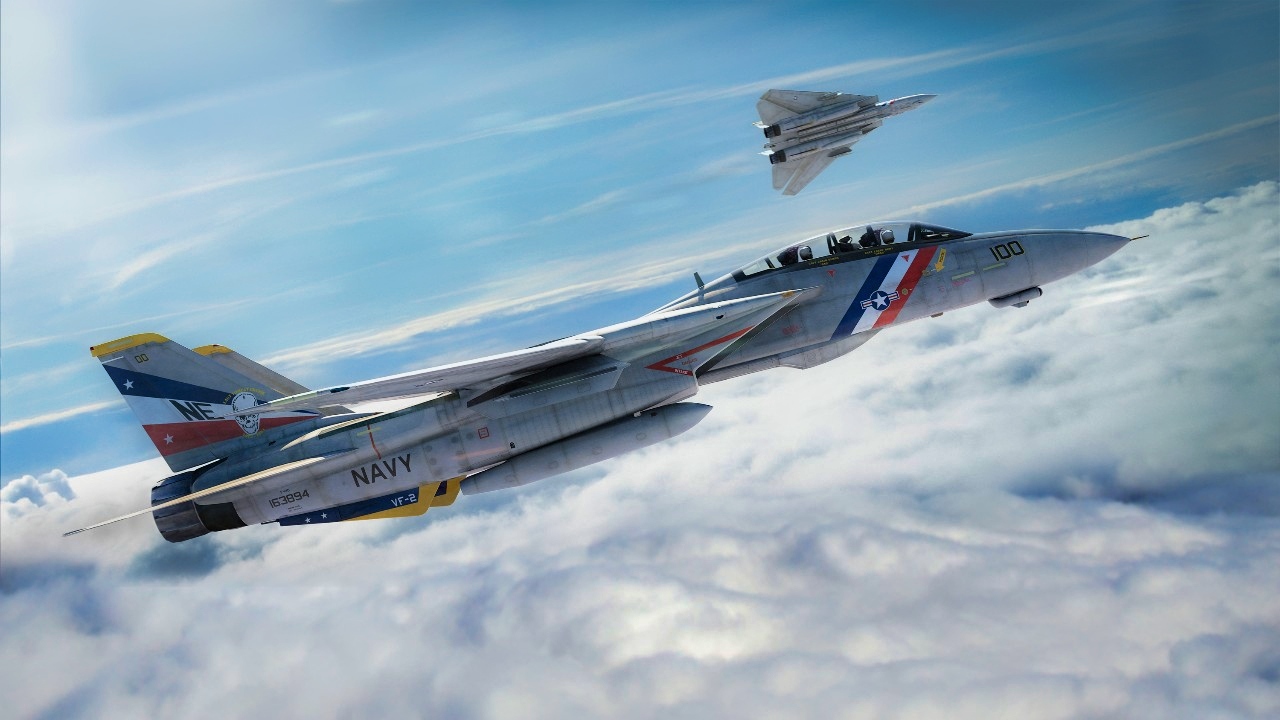Key Points and Summary – The Navy needed a carrier fighter that could stop Soviet bomber raids before they reached the fleet—and still win if the fight collapsed to a merge.
-Grumman’s F-14 delivered: variable-sweep wings for carrier launches and supersonic dash, the AWG-9 radar to track many targets at once, and AIM-54 Phoenix missiles for long-reach kills.

NASA 834, an F-14 Navy Tomcat, seen here in flight, was used at Dryden in 1986 and 1987 in a program known as the Variable-Sweep Transition Flight Experiment (VSTFE). This program explored laminar flow on variable sweep aircraft at high subsonic speeds. An F-14 aircraft was chosen as the carrier vehicle for the VSTFE program primarily because of its variable-sweep capability, Mach and Reynolds number capability, availability, and favorable wing pressure distribution. The variable sweep outer-panels of the F-14 aircraft were modified with natural laminar flow gloves to provide not only smooth surfaces but also airfoils that can produce a wide range of pressure distributions for which transition location can be determined at various flight conditions and sweep angles. Glove I, seen here installed on the upper surface of the left wing, was a ”cleanup” or smoothing of the basic F-14 wing, while Glove II was designed to provide specific pressure distributions at Mach 0.7. Laminar flow research continued at Dryden with a research program on the NASA 848 F-16XL, a laminar flow experiment involving a wing-mounted panel with millions of tiny laser cut holes drawing off turbulent boundary layer air with a suction pump. April 11, 1986 NASA Photo
-Built from the VFX program after the F-111 proved too heavy for decks, the two-seat Tomcat paired a pilot with a RIO to manage sensors and shots.
-Combat from the Gulf of Sidra to the Gulf War confirmed the design logic: intercept first, dogfight if needed, protect the carrier.
Why The Navy Wanted The F-14 Tomcat
The US Navy wanted the F-14 Tomcat for long-range fleet defense against Soviet bomber threats, requiring a large radar, powerful air-to-air missiles, and the ability to operate across a wide range of airspeeds to carry heavy ordnance and maintain maneuverability.
The variable-sweep wing design, combined with advanced fire-control systems and the AIM-54 Phoenix missile, made the F-14 capable of engaging multiple targets at long distances while still being able to perform close-in combat and dogfighting.
The Tomcat was born from the Cold War, where the Navy expected the Soviets to unleash a torrent of bombers over the world’s oceans, firing a fusillade of missiles at the Navy’s carrier task forces. US missile defenses on the ships were very good, but the vessels needed advanced fighters to defend against the bombers and then engage the fighters accompanying them.
Meet The F-14 Tomcat
When the discussions began for a replacement of the F-4 Phantom jets in the Navy’s carrier air wings, an evaluation was done on the F-111 Aardvark, the Air Force’s fighter-bomber. This would allow continued commonality between the Air Force and the Navy, but the Aardvark was far too heavy for carrier operations.
The Navy instituted the VFX program for the solution. Grumman designed its Model 303, which proposed a variable-geometry, two-seat, twin-engined design built around the Hughes AWG-9 weapons system.
Grumman had gained considerable experience with “swing-wing” technology from its earlier XF10F Jaguar that had been built only as a prototype. However, the wing design of the A-6 Intruder greatly influenced the technology for the F-14.
The need for rapid development and fielding of the aircraft dictated the adoption of Pratt & Whitney TF-30 turbofans similar to those used in the F-111. Those propelled the F-14 to 1,544 mph.
The aircraft’s armament consisted of a M-61 20mm cannon; four AIM-7 Sparrow, four AIM-9 Sidewinder, or six AIM-54 Phoenix, and two AIM-9 air-to-air missiles.
Grumman had a history of naming its aircraft after cats, so the new “Tomcat” made its first flight in December 1970. After a number of changes following flight testing, the first F-14As were delivered to the Navy in June 1972.

F-14D Tomcat. Image Taken By National Security Journal.
In 1974, the Marine Corps prepared to stand up VMFA-122 at NAS Miramar, but the program was cancelled when the Marine Corps decided to retain modified versions of the dependable F-4J Phantom II.
The Tomcat’s “Swing Wing” Technology
The Tomcat variable-geometry wings could automatically swing from a twenty-degree angle up to sixty-eight degrees while in flight. Aircraft with smaller wing surfaces can attain higher speeds, but to take off from short runways—such as carrier runways—requires more wing surface to generate lift.
The Tomcat was designed to keep its wings extended while taking off, landing, and flying at low speeds, and swept in during high-speed dashes. The Tomcat’s wings could be tucked up to seventy-five degrees when parked to make them easier to stow under the carrier’s deck.
The AWG-9 Weapons System
The Tomcat’s AWG-9 was the most powerful radar in operational service on combat aircraft until the F-22 Raptor with the APG-77 entered service in 2005.
It had six basic working modes. The Pulse-Doppler Single Target Track (PDSTT) mode was used for long-range AIM-54 missile launches and for attacks on targets emitting strong electronic countermeasures (ECM). The Phoenix missile could hit targets over 120 miles away, traveling at speeds up to Mach 5.
The sophisticated radar and missiles were operated by the backseater on the F-14, known as the Radio Intercept Officer (RIO). About five years ago, I had the pleasure of making the acquaintance of Dave “BIO” Baranek, and he sent me a copy of his book, which I reviewed while working for SOFREP. He was a backseater (RIO) in ‘Cats and helped with “Top Gun.”
Still, it could also be deployed to guide AIM-7 Sparrows out to a range of 70km (38nm) or AIM-9 Sidewinders out to a range of 16km (10nm).
The Tomcat Was a Great Aircraft
The F-14 Tomcat was fast enough to intercept Soviet bombers, had radar and missiles capable of detecting and shooting them down over long distances, and the maneuverability to dogfight and defeat agile enemy fighters.
It was one of the best fighters in the world at the time.
The F-14 saw its first combat in August 1981, downing two Libyan Su-22 fighters over the Gulf of Sidra after the Libyans fired a missile at a Tomcat that was escorting an S-3 Viking.
Eight years later, in 1989, two Libyan MiG-23s confronted F-14s from the USS Kennedy, again over the Gulf of Sidra. This time, the American fighters shot down both Libyan aircraft with a Sparrow and a Sidewinder missile.

F-14 Tomcat US Navy. Image Credit: Creative Commons.
It saw considerable duty in the Gulf War, Iraq, and Afghanistan. The last F-14 retired from active service with VF-213 in 2006.
One of the more intriguing aspects of the F-14 was that it saw the most amount of combat since Vietnam of all US fighters, but it only shot down five enemy fighters.
However, the Iranians, to whom the US sold 78 Tomcats when the Shah was in power. During the Iran-Iraq War, Tehran claimed to have shot down dozens of Iraqi aircraft with the Tomcats.
About the Author: Steve Balestrieri
Steve Balestrieri is a National Security Columnist. He served as a US Army Special Forces NCO and Warrant Officer. In addition to writing on defense, he covers the NFL for PatsFans.com and is a member of the Pro Football Writers of America (PFWA). His work was regularly featured in many military publications.
More Military
F-14 vs. MiG-29: The Winner Is Clear
The Eurofighter Might Be Able to Beat the F-35
Seawolf-Class: The Best Submarine Ever?










